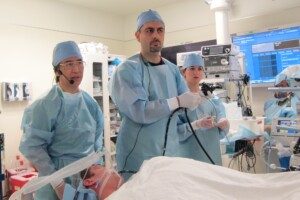There are several reasons for difficulty swallowing.
The causes of this symptom, called dysphagia, range from the benign and self-limited such as the sensation of a “lump in the throat” accompanying an emotional event such as saying goodbye, to the devastating development of esophageal cancer.
Because of the latter possibility, in my practice of thoracic surgery, and in agreement with what has been recommended here before, I always espoused evaluation of any complaint of difficulty swallowing that persisted and/or was bothersome enough for someone to mention it to a physician.
Obtaining a few normal barium swallow X-rays — a well-tolerated and non-invasive procedure — seems an appropriate price to pay for the opportunity to detect a cancer in its early stages.
Occasionally the evaluation of dysphagia will detect an uncommon malady called achalasia — combining “a” meaning “not” and “chalasia” meaning “relaxing.”
I discuss this disorder in my recent book, “Cracking Chests: How Thoracic Surgery got from Rocks to Sticks,” (written for the general reader, not physicians).
The typical patient recalls difficulty swallowing beginning in their teens but sometimes as early as infancy.
Several of my patients told me their mother often commented how excessively, even for an infant, they regurgitated.
As they age many patients shift to softer foods and liquids to accommodate the dysphagia, but eventually the difficulty swallowing is intolerable — and in their 20s they seek medical attention.
What’s wrong?
Two normal features of the esophagus, the tube that transports food from the mouth to the stomach, are misfiring.
These functions propel food toward the stomach; the esophagus doesn’t simply empty by gravity.
There should be sequential contractions, called peristalsis, to squeeze food toward the stomach.
Achalasia disrupts this; patients have only weak and uncoordinated contractions that cannot push food along.
The other deranged esophageal feature is the action of a muscular band at the bottom of the esophagus which normally is contracted, creating a squeeze which prevents acid reflux. A swallow causes temporary relaxation to let food pass through.
In achalasia this muscle, called the lower esophageal sphincter, maintains its squeeze so that swallowed food meets an obstruction.
Frustratingly we do not know the etiology, the cause, of this disorder. We do know the nerves of the esophagus are affected.
Infection is speculated (there are similarities to Chagas disease which is caused by a parasite) as well as an autoimmune disorder, or an infection causing an autoimmune response.
These abnormalities of function are detected with an esophageal motility study — which is carried out with a catheter passed through the nose and into the esophagus — where is detects and measures these two aspects of esophageal function.
The consequence of these two areas of malfunction is a scenario as follows.
Food accumulates in the esophagus until the weight of this pile is sufficient for it to overcome the squeeze of the lower esophageal sphincter and some food to squeeze through.
This is initially inefficient but tolerable. Inevitably the person finds themselves at a point where little or nothing gets through; starvation is on the horizon.
Therapeutic intervention, of which there are several, is necessary. These palliative treatments improve swallowing — but cure, however, is not in the cards.
Using an endoscope inside the esophagus, Botox can be injected into the lower esophageal sphincter producing relaxation.
This maneuver provides relief but only temporarily. Months later the sphincter recovers and dysphagia returns.
More definitive interventions are required. Stretching of the offending muscle with a dilator through the mouth, once popular, is infrequently used today.
Now the most widely employed intervention is to actually cut the sphincter muscle to reduce its squeeze.
This can be done in two ways: A surgeon can cut the muscle during a laparoscopic operation.
This minimally invasive procedure has good results, very few complications and gets the patient home quickly.
Recently introduced is a technique to cut the muscle during an endoscopic procedure.

An endoscopic procedure to treat an esophageal swallowing disorder. Cutting the muscle is known as myotomy. Mgaidhane, CC BY-SA 4.0creativecommons.org/Wikimedia Commons
This approach has the benefit of not requiring even a minimally invasive operation.
The jury is out as to which of the two alternatives is best. I believe the laparoscopic procedure is most likely to hold up over time, but I confess to a personal bias: I performed this procedure regularly during my surgical career.
Does achalasia mean a higher risk for esophageal cancer?
In earlier days it was thought that the incidence of esophageal cancer was higher in the esophagus afflicted with achalasia than otherwise.
In recent years this increased risk seems to have abated.
Nonetheless, endoscopy is routinely performed in achalasia patients, primarily to ensure there is not inflammation to interfere with healing after surgery — but also to be sure the dilated esophagus is not harboring an occult carcinoma.
As an ending note I can say with confidence both treatments are preferable to the first recorded account.
In 1674 an English physician, Thomas Willis, encountered a patient. As I put it in my book: Willis took a whale’s rib (something the prepared physician of the day apparently kept on hand), wrapped its tip with a sponge and had the patient pass this device through his mouth, exactly as a sword swallower would do, and push the food, which had collected in the lower esophagus, past the lower esophageal sphincter and into the stomach.
I observed, This maneuvering with the whale bone plunger kept the man from starving to death, but we might imagine he encountered some difficulty in retaining dinner companions.
Alex Little, MD, trained in general and thoracic surgery at the Johns Hopkins University School of Medicine; has been active in national thoracic surgical societies as a speaker and participant, and served as president of the American College of Chest Physicians. He’s the author of “Cracking Chests: How Thoracic Surgery Got from Rocks to Sticks,” available on Amazon.
.











































